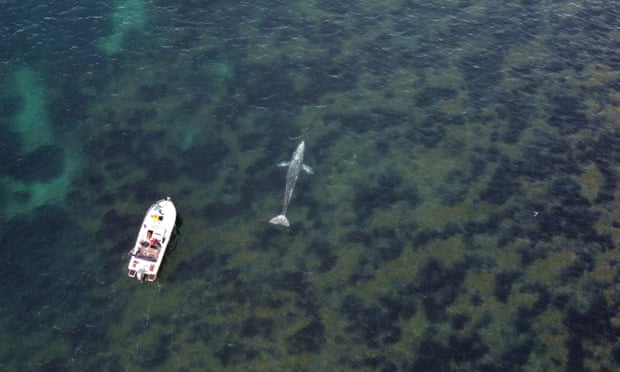The Paper's reporter Qian Chengxi
Recently, French scientists found a lost gray whale on the Mediterranean coast, and they named it "Wally".
The gray whale's natural habitat is in the eastern and northern Pacific Oceans, and today, it is desperately looking for a way home when it strays into the Mediterranean Sea, but scientists worry that it will not survive because the Mediterranean seas cannot provide it with suitable food.

Scientists' boats track Wally in the Mediterranean
It was first seen in early March, when it wandered off the coast near Rabat in Morocco. Wally is eight meters long and only about two years old, while its companions live and migrate more than 10,000 kilometers away on the coast of California. Scientists believe that the Arctic ice melted due to global warming, causing it to swim through the Arctic and swim into the Atlantic Ocean.
From March to the present, people have followed its route: it has passed through the Strait of Gibraltar, from the Atlantic Ocean into the Mediterranean Sea, from the coast of North Africa to southern Italy and southern France, from Naples to the Côte d'Azur. The Mediterranean Sea became a trap that trapped it. And in the process, it's getting thinner and weaker.
"We are very worried about his future because his fat has dropped a lot and he is now exhausted and skinny." Eric Hansen, head of the National Biodiversity Agency of the South of France, said: "We haven't seen it eat since we started tracking it. ”
Scientists take skin samples from Wally for study
Wally travels about 80 to 90 kilometers a day and is currently approaching the Spanish coast.
"It's trying to get into port, seemingly to find a way out. We hope it will return to Gibraltar in about a week. Hansen said.
A few days ago, it had been entangled in fishing nets and had since broken free on its own. But experts fear that after it enters the Strait of Gibraltar, the busy water traffic will hurt it more.
"We may see this more often, because climate change is not only opening up the northern shipping lanes, the melting of the ice sheet is also changing ocean currents, causing more marine animals to get lost," Hansen said. ”
Indeed, it is not only this poor gray whale that is lost. On 9 May, a trapped minke whale was spotted in the River Thames. It was stuck in the locks of Richmond, and in the early hours of May 10, it finally escaped thanks to the efforts of rescuers, but somehow it returned to Richmond. In the water, it stood still, and rescuers said it had been badly injured and exhausted from the previous runground, most likely unable to be saved.
Minke whale stuck in the sluice gate video screenshot
In November 2019, a patrol boat on the River Thames spotted a dead minke whale under Battersea Bridge in London. Reports at the time said it was already the 27th lost minke whale in the UK this year and the third whale to die in the River Thames in two months.
Stress, weakness, disorientation and heavy water traffic can all lead to such tragic results.
Dead minke whales found in the River Thames
In addition to whales, there are other marine animals that occur frequently in human activity areas. Common seals and harbor seals inhabit the North Atlantic, but in recent years they have been active along the River Thames and have become accustomed to humans. One of the baby seals that often appears on the River Thames near Hammersmith Bridge in London was even named by locals after the late Queen's lead singer Freddie Mercury.
However, for wild animals, getting too close to humans is actually quite dangerous. On March 24 this year, while basking in the sun on the riverbank, an unchained pet dog suddenly ran over and launched a fierce attack on it. After being admitted to the veterinary hospital, the veterinarian had to euthanize the seal because of the injuries.
In March, a walrus travels south from the North Atlantic to the coast of Ireland and stops at the area, becoming a sight for tourists to witness. But when it occupied the lifeboat passage, people had to use various methods to blast it back into the sea.
The walrus became a local sight, but it wasn't a good thing for it
British nature writer Philip Hoare says marine mammals are showing up where they shouldn't be.
Ironically, gray whales once roamed the Atlantic Ocean until this population disappeared with the ferocious whaling industry of the 19th and 20th centuries. The grey whale's nickname , " Manta Ray " , comes from this history because it frantically attacks whaling boats , causing panic among fishermen. But the truth is, this was due to the brutal whaling methods of the time – because adult gray whales would take a group approach to protect their children, whalers usually chose to attack juvenile whales to attract flocks of gray whales to catch them all.
I wish "Wally" a smooth return home.
Editor-in-Charge: Ying Xu
Proofreader: Liu Wei